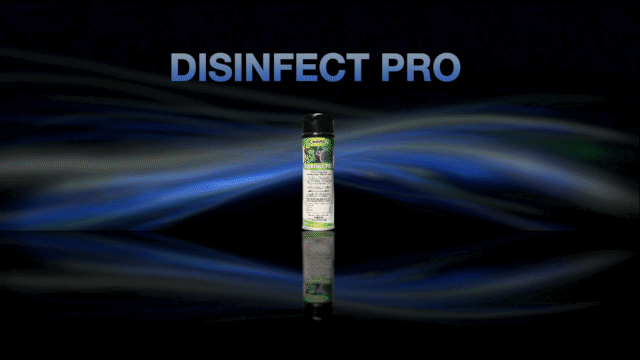
The Professional’s Guide to Fall HVAC and Facility Disinfection with Disinfect Pro
Introduction: A Strategic Approach to Fall Maintenance
As an HVAC professional, fall is a critical time for preventative maintenance. Beyond standard servicing, this season offers a prime opportunity to address indoor air quality and hygiene. With people spending more time indoors and the onset of cold and flu season, a proactive HVAC and facility disinfection strategy is essential. Disinfect Pro is a versatile, all-purpose tool for both core HVAC system cleaning and broader facility maintenance.
Part I: The Solution to Core HVAC Problems
After a season of heavy use, HVAC evaporator coils and drain pans become ideal breeding grounds for microbial growth. This buildup impacts system performance, reducing efficiency, increasing energy consumption, and circulating contaminants. Disinfect Pro is formulated to directly address these issues, helping you to inhibit microbial growth, restore system efficiency, and support healthier indoor air quality.
Part II: Expanding Your Services to the Entire Facility
Your expertise in indoor air quality positions you as a trusted advisor for overall facility health. Disinfect Pro’s USDA authorization opens up significant market opportunities, allowing you to expand your services to sensitive environments like restaurants, commercial kitchens, and schools. By offering comprehensive HVAC and facility disinfection, you can help clients reduce absenteeism and maintain a healthier environment for everyone.
HVAC and facility disinfection: Your Questions Answered
For a detailed breakdown of the product, safety, application protocol, and more, explore our frequently asked questions below.
Frequently Asked Questions: A Guide to **HVAC and Facility Disinfection** with Disinfect Pro
1. What is the difference between cleaning, sanitizing, and disinfecting?
It's a great question that shows you're focused on doing the job right. Here’s a simple breakdown:
- Cleaning removes visible dirt, grime, and debris from a surface.
- Sanitizing lowers the number of germs on surfaces to a safe level, as judged by public health standards.
- Disinfecting uses chemicals to kill germs and microorganisms on surfaces. Disinfect Pro is an EPA-registered disinfectant designed to kill mold, mildew, and odor-causing bacteria on hard, non-porous surfaces. It's a critical step in effective **HVAC and facility disinfection**.
2. Is Disinfect Pro safe to use on HVAC evaporator coils and other components?
Yes, it is. Disinfect Pro is specifically formulated for use on hard, non-porous surfaces commonly found within HVAC systems, such as evaporator coils and drain pans. Using the right product is essential for a complete **HVAC and facility disinfection**.
3. The article and label mentions "USDA Authorization." What does that mean for me and my clients?
USDA Authorization means that the product's chemistry has been reviewed and is considered acceptable for use in and around food processing areas, such as federally inspected meat and poultry plants. For you as a contractor, this is your most powerful selling point for clients in sensitive environments like restaurants, commercial kitchens, and schools. It immediately tells them the product meets a high standard for use where safety and compliance are critical for proper **HVAC and facility disinfection**.
4. Will the product leave behind a harsh chemical smell for my client?
That's an excellent question. Disinfect Pro aerosol has a light, fresh citrus scent during application, but it is not an overpowering air freshener. The scent is specifically designed to dissipate quickly from the environment, leaving the space smelling genuinely clean and neutral once the area is dry. The primary goal is to eliminate the underlying sources of malodor—like mold and bacteria—not to mask them. So, the final result your client will notice isn't a lingering fragrance, but the welcome absence of the old musty or "Dirty Sock Syndrome" smell, which is a key part of **HVAC and facility disinfection**.
5. Why is the 10-minute "dwell time" so important? Can I speed it up?
Dwell time (or contact time) is the period a disinfectant must remain visibly wet on a surface to effectively kill the germs listed on its label. Shortening this time drastically reduces the product's efficacy. Adhering to the full 10-minute dwell time for Disinfect Pro is critical to ensure you are actually disinfecting the surface, not just cleaning it. This step is non-negotiable for effective **HVAC and facility disinfection**.
6. Do I need to rinse the evaporator coil after applying Disinfect Pro?
For HVAC applications on coils and drain pans, a post-application rinse is generally not required. The product is designed to do its job and then dry. However, for any food-contact surfaces (like a kitchen counter), a potable water rinse is required after disinfection. Always read and follow the specific directions on the product label for the surface you are treating. Proper rinsing is a vital component of successful **HVAC and facility disinfection**.
7. How do I explain the value of this service to a hesitant client?
Frame it as a solution to their problems. Instead of just "disinfecting the coil," explain that you are "eliminating the source of that musty office smell" or "improving system efficiency to help manage energy costs." Connect the service to tangible benefits they care about: better air quality for their staff and customers, preventing future issues, and creating a healthier, more pleasant indoor environment. Communicating these benefits is key to selling your **HVAC and facility disinfection** service.
8. How often should this disinfection service be performed?
For residential and most commercial HVAC systems, offering a disinfection service as part of a semi-annual maintenance plan (especially in the fall and spring) is a great baseline. For high-traffic or sensitive environments like healthcare facilities, schools, or busy restaurants, a more frequent facility-wide disinfection protocol for high-touch surfaces may be recommended to help them maintain a higher standard of hygiene. This regular service is vital for successful **HVAC and facility disinfection**.
